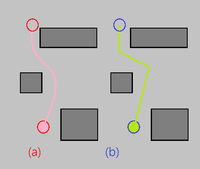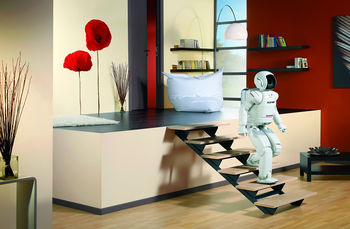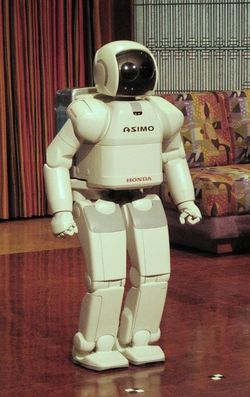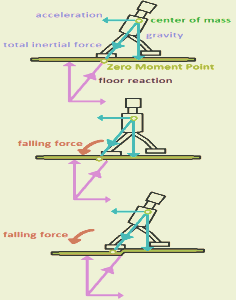ASIMO
ASIMO (アシモ ashimo) is the world's most advanced humanoid robot, developed by the Japanese company Honda. The first ASIMO was completed after 15 years of research, and it was officially unveiled on October 31, 2000. The robot resembles a small astronaut wearing a backpack, and is capable of performing a variety of tasks, including running, kicking a ball, walking up and down stairs, and recognizing people by their appearance and voice. The name is short for "Advanced Step in Innovative MObility" and is also known as an abbreviation of ashita no mobility, meaning 'mobility in the future.'[1] It was named in reference to Isaac Asimov, an American professor and science fiction writer who is credited with coining the term robotics and proposing the Three Laws of Robotics.
Design concept
"Following in the steps of Honda motorcycles, cars and power products. Honda has taken up a new challenge in mobility - the development of a two-legged humanoid robot that can walk."[2]
Bipedal movement has been the primary focus of Honda's humanoid robotic research to create general-purpose, intelligent robots that can "coexist and cooperate with humans",[3] since it began in 1986 with the development of the 'E0' prototype. While there existed many different visions of futuristic robots, such as R2-D2 and C-3PO from Star Wars, it was recognized that human-like robots with bipedal mobility are the most ideal for operating and interacting with humans in human surroundings.[4]
Based on this concept, ASIMO's design concerns three main elements, which are human-friendliness, adaptability to the human environment, and engineering feasibility. The robot's height was set at 120 cm (or 130 cm in the case of second-generation ASIMO), which is similar to a child's, as this would be practical both on the engineering aspect (since a smaller and lighter robot is less challenging than an adult-sized robot such as the P2 prototype) and the question of operability in the environment, where light switches are normally located 110 cm from the floor. With less bulk, the robot would be able to move more efficiently in handling obstacles and narrow passages,[5] and it would also be less overwhelming presence to humans and, in case of accidents, less hazardous.
Its humanoid form that is not only functionally but also proportionally similar to the human body was meant to enhance its human and environment-friendly qualities by allowing it to make gestures and communicate face-to-face, as well as using the stairs or taking seat in a car. Its strikingly minimalist appearance, which lacks a detailed face and toes on its feet, provides fewer moving parts as rooms for error, while being clearly discernible to humans as consisting of a head, torso, arms, hands, legs, and feet. ASIMO being a popular icon, its design has contributed to the conceptual diversity of futuristic robots, based on a very unique design language of modern Japanese aesthetics.[6]
Honda has suggested several future uses for robots like the ASIMO, which, despite its impressive list of feats and features, remains an experimental technology demonstrator that needs to operate in controlled, predictable environment. With further advances, ASIMO could be engaged in useful tasks such as elderly care assistance, firefighting, and toxic cleanup.[7] At the present, the ASIMO is being leased to companies for receptionist work.[8]
On August 12, 2011, the Japanese newspaper Asahi Shimbun reported that Honda was seeking to develop a robot based on the ASIMO to handle the radiation leakage at the Fukushima nuclear power plant that resulted with the earthquake and tsunami that hit Japan in March, 2011:[9]
If successful, in another year or two, an improved version of the Asimo could be taking over the work at the Fukushima site... Adjustments can be made to the degree of strength that is applied in the robot's shoulder, elbow and wrists that are operated by motors. While using the Asimo as the base, Honda officials want to create a robot devoted exclusively for working at the nuclear accident site by taking advantage of the arm technology of the Asimo. Because the footing at the Fukushima site is treacherous due to rubble that could topple the robot, the biped aspect of the Asimo would be replaced by either tires or crawlers used on tanks.
According to the AFP, US Honda spokeswoman Lauren Ebner denied the report, dismissing it as a mere "speculation."[10]
Technology
ASIMO v1
System structure
ASIMO's control system includes approximately 20 CPUs and sensors that are grouped into several independent sub-systems interacting asynchronously through an internal message board. Each sub-system is essentially a PC with different operating system and are responsible for audio-visual sensory and recognition, communication with the operator, actuation of movement, and power management. The internal message board is updated at different frequencies due to the different processing load and power of each sub-system. Contrary to the popular belief, the system activities are event-driven without a central, intelligent AI to handle unexpected situations.[11][12]
Sensory
ASIMO's sensors are responsible for visual, auditory, and tactile functions, as well as those relating to movement, such as the gyro sensor, force sensor, and inclinometer.[11] In human terms, it is limited to three senses as it lacks particle detectors that can substitute for the nose or tongue and the emotional capacity to react in the manner of either appreciation or disgust.
ASIMO's vision system is responsible for processing spatial perception, object-mapping, human tracking, facial recognition, and gestural-postural detection. It relies on stereo images (of two views from slightly different angles) provided by the frame grabber that is connected to the two color board cameras on the head unit of the robot. 3D and moving objects are identified by calculating depth of space based on the Sum of Absolute values of Differences (SAD) method using the images that are captured in black-and-white and callibrated for lens distortion. A local map of 3D objects is constructed and provided to the agent programs for walking and movement. The vision system also identifies moving parts of the moving objects, from which the recognition of human gestures and postures is processed and provided to the agent programs for human-robot interaction and eye control.[13]
ASIMO can identify muliple people in a scene by using the snake algorithm to distinguish the contours of human shapes. When in motion, ASIMO tracks humans by using an optical flow-based algorithm to lock on their changing positions in the image data. 2D gesture recognition algorithm can identify handshake, hand-circling, farewell, hand swing, high hand, and come here-call based on the probabilities for a given position of the hand using the Bayes statistical model. 3D gesture recognition algorithm can identify where a person is pointing at based on the relative positions of the person's head and hand from the depth map data. Face is recognized by applying the Eigenvector Method on the face contour and eye image data.[13]
ASIMO relies on the sound data to be situationally aware of the surrounding outside its field of vision. The sound's direction is calculated based on the volume and time differences of the signals at two separate microphones. It can discern human voices and footsteps from the sound data and look when a person calls its name, or something falls on the floor.[13]
Movement

(a) With intelligent real-time flexible walking or "i-WALK," walking cycle and stride are adjustable. (b) Prototypes were unable to make small directional changes while in motion but needed to pause between straight and turning phases because their walking cycle and stride were unchangeable.
ASIMO's bipedal movement comprises of highly sophisticated functions involving "dynamic" walking based on real-time sensory feedback and predictive movement planning, which allow ASIMO to flexibly adjust its course while continuing to move in real time. This contrasts with earlier ways of walking demonstrated by ASIMO's prototypes that followed pre-programmed walking patterns with fixed time per step.[14]
Humans rely on information regarding the linear and angular speeds provided by the ears' inner parts (otolith and semicircular canals respectively) and the sensations from the muscles and skin relating to joint angle, angular speed, muscle power, and pressure. In the ASIMO, the joint angle sensors are used to determine the positions and angles of the body parts; 6-axis force sensors, the force and torque of each motors in the x, y, z coordinates; speed sensor, the overall movement speed of the robot; and gyroscope (and inclinometer), the overall orientation relative to the artificial horizon.[11][15]
Unlike WABIAN-2 by Japan's Waseda University or HUBO 2 by KAIST which are capable of "straight-legged walking" like humans, ASIMO bends its legs to maintain a stable movement pattern based on Zero Moment Point trajectories that are simple but versatile for the purpose of predictive movement planning. Zero Moment Points are mathematically-conceived contact points where the ground reaction force to the position of the supporting leg equals the total inertia force (i.e. gravity and forward accelerating or decelerating force).[16][17]
ZMP dictates ASIMO's stable movement pattern through a three-layered system consisting of "floor reaction control", "target ZMP control", and "foot planting location control". Floor reaction control absorbs irregular floor impact by adjusting the feet to align the point of floor reaction to the target ZMP. Target ZMP control activates when the floor reaction control fails, and the soles of the feet cannot plant firmly to the ground. In that case, the target ZMP is itself changed by deviating from the ideal movement pathing by accelerating the upper torso (which contains most of the robot's mass) in the direction of the falling force. Foot planting location control corrects the irregular outcome of target ZMP control by changing the length of stride to accomodate for the changed torso speed.[16]
An important but easily unnoticed characteristic of ASIMO's bipedal movement is that it involves bending of the legs, which lowers the center of gravity and keeps constant the height of the hips. This is contrary to the widely-spread thinking that ASIMO's "...walk is modeled on a human being's."[15] The constant height of the hips, which makes simpler the inverse kinematics of ASIMO's movement, is the basis for the real-time predictive movement-planning technology.[18] When ASIMO walks, it predicts an ideal movement path consisting of Zero Moment Points and tilts its body sideways or forward to shift its center of gravity in anticipation. Real-time predictive movement-planning enables ASIMO to make minor adjustments to its movement path, which is superior to the earlier method of walking by changing gears between different walking patterns to arrive at a destination.[19]
Other basic movements of ASIMO, some of which were also demonstrated on previous prototypes, include climbing and descending stairs, pushing a cart, carrying things, passing through doorways, and shooting a ball.[20]
ASIMO v2 changes
ASIMO v3 changes
Development history
notes
- ↑ Masato, Hirose and Ogawa Kenichi, 2006. pp. 14
- ↑ "ASIMO Technology." Honda Worldwide. Honda Motor Co.,Ltd. Web. 24 Aug. 2011. <http://world.honda.com/ASIMO/technology/>.
- ↑ Pfeiffer, Friedrich, and Hirochika Inoue, 2007. pp. 5
- ↑ Masato, Hirose and Ogawa Kenichi, 2006. pp. 11
- ↑ Masato, Hirose and Ogawa Kenichi, 2006. pp. 15
- ↑ Mansfield, Stephen. "Japanese Aesthetics and High-Tech Design." Nov. 2001. J@pan Inc. Japan Inc Communications, Inc. Web. 10 Oct. 2011. <http://www.japaninc.com/article.php?articleID=515>.
- ↑ "ASIMO Technical Guide". pp. 18
- ↑ Sakagami, et al, 2002. pp. 2478
- ↑ Hashimoto, Yukio. "Honda to Improve Robot to Work at Fukushima." The Asahi Shimbun. The Asahi Shimbun Company, 12 Aug. 2011. Web. 9 Oct. 2011. <http://ajw.asahi.com/article/0311disaster/recovery/AJ201108126075>.
- ↑ AFP. "Honda Denies Nuclear Robot Mission." The New Zealand Herald. 15 Aug. 2011. Web. 10 Oct. 2011. <http://www.nzherald.co.nz/japan/news/article.cfm?l_id=57>.
- ↑ 11.0 11.1 11.2 Masato, Hirose and Ogawa Kenichi, 2006. pp. 16-17
- ↑ Sakagami, et al, 2002. pp. 2479-2480
- ↑ 13.0 13.1 13.2 Sakagami, et al, 2002. pp. 2480-2481
- ↑ "ASIMO Technical Information." pp. 17-18
- ↑ 15.0 15.1 "ASIMO Technical Information." pp. 7-8
- ↑ 16.0 16.1 "ASIMO Technical Information." pp. 9-10
- ↑ Masato, Hirose and Ogawa Kenichi, 2006. pp. 18
- ↑ Kim, Kim et al, 2008. pp. 118.
- ↑ "ASIMO Technical Information." pp. 19-20
- ↑ "ASIMO Technical Information." pp. 11





